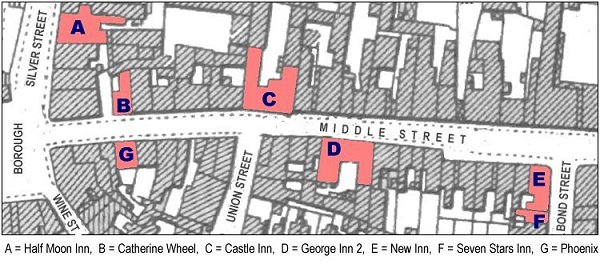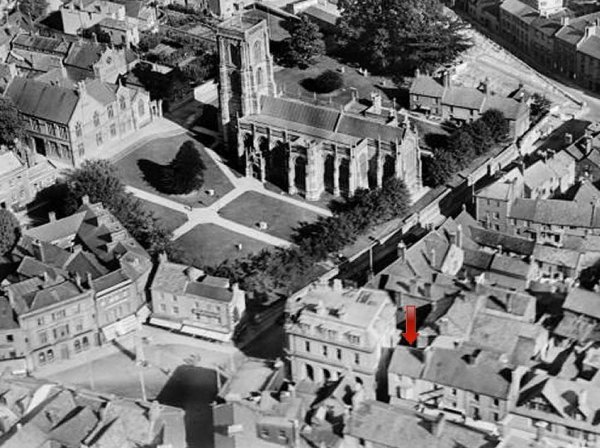the history of yeovil's pubs
PUBS HOME PAGE |
PUBS INTRODUCTION |
PUBS BY NAME |
BEERHOUSES |
catherine wheel
Middle Street
The Catherine Wheel (shown as 'B' on the map below) was an alehouse mentioned in a lease of 1772 which refers to an adjoining right of way and usage of a well, through a yard belonging to the Catharine Wheel Alehouse. It was also mentioned in a lease of 1788 (see under 'Documentation' below).
Watts 1829 Map
of Yeovil shows
the location of
the Catherine
Wheel to have
been that now
occupied by
Ryman's
stationers shop
in
Middle
Street,
adjoining the
alleyway next to
the HSBC bank.
The 1822 Chantry
Commissioners
Report regarding
the Church (or
Parish) House,
stated that the
site, now
occupied by the
Midland Bank,
was on the
corner of Middle
and Silver
Streets.
The Catherine
Wheel was still
open in 1856
when it was
mentioned in
Vickery's
'Sketch of
Yeovil' -
"In the lease of
1778 a cellar
and yard are
mentioned, and
it was
conjectured that
this cellar and
yard were sold
in 1788, by the
executors of
Ambrose Seward,
(one of this
family was Vicar
of Yeovil)
together with a
public house
adjoining,
called the
Catherine Wheel,
which belonged
to Mr Seward;
but there is no
proof of it."
map

gallery

The notice of sale placed in the 2 August 1830 edition of the Western Flying Post, giving a good indication of the size of the property. It probably didn't sell at this time as the notice was repeated almost exactly in the 14 February 1831 edition of the Western Flying Post.

From my
collection. This
colourised photograph
features in my
book "Lost Yeovil"
This photograph is one of the earliest on this website. It was taken about 1860 by Bridport photographer William Barrett and shows the Borough as seen from High Street. The building at left is the only one surviving (it was Kitchen Mate) and was originally the Deposit Bank - Yeovil's first purpose-built savings bank and the initials 'DB' are still visible today at high level. At centre is the entrance to Middle Street. The building at left, London House, belonged to Thomas Thorne, draper, and was replaced in 1914 by the present building - originally the Midland Bank, now the HSBC. Next to it is the site of the Catherine Wheel building. On the right is the Medical Hall, later Boots the Chemist. This building was destroyed by a German bomb on Good Friday in April 1941. At least they didn't get the pubs in Wine Street that runs off next to it, to the right.

This photograph dates to about 1900 and is taken from the Borough looking to the western end of Middle Street. Thorne's shop, at left with the awnings, is London House and to the right, with the bay window at first floor, is the old Catherine Wheel building.

This 1928 aerial view of the town is dominated by St John's church and the churchyard. The Borough is at bottom left and Silver Street runs from it to Court Ash at top right. The location of the Catherine Wheel, arrowed, is now occupied by Ryman's.

The site of the Catherine Wheel in the 1960's occupied by Willson's dress shop.
owner / licensee
pre-1784 - Ambrose Seward, owner
documentation
|
1788 |
In the lease granted in 1788, a cellar and yard are mentioned; and it has been suggested that this cellar and yard were sold in 1788 by the executors of Mr Ambrose Seward, as freehold property, together with a public house adjoining called the Catherine Wheel, which belonged to Mr Seward; but we cannot ascertain that there has been any loss in this part of the trust property... There appears to have been formerly a doorway from the trust premises to the yard of the Catherine Wheel, but it is probable that this communication was made by Mr Seward who was owner of the latter as well as lessee of the former and again stopt up when the property was sold in 1788; for a lease of the Catherine Wheel, granted by Mr Seward's executors in 1784, we find an exception of the use of a well, etc., in or near the yard of the demised premises reserved to the lessee and their tenants occupying the messuage adjoining them in possession of John Handcock. |